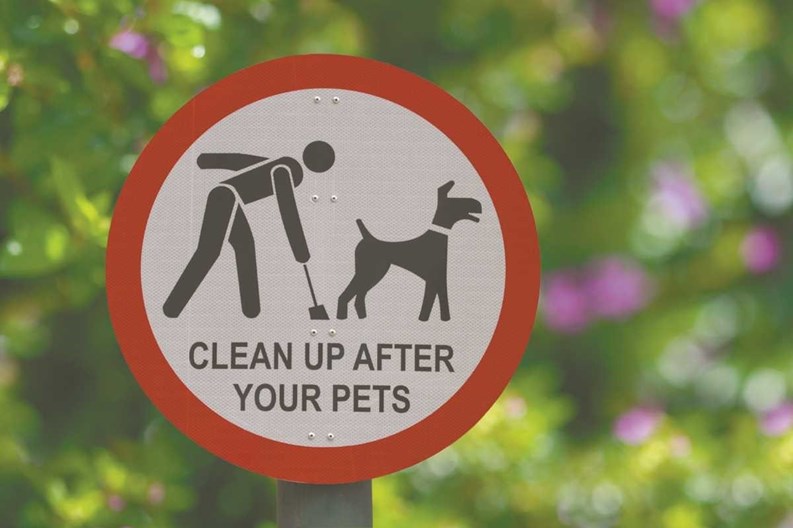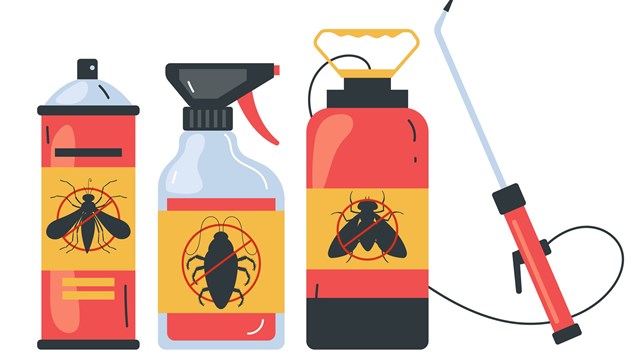The signs “Post No Bills,” “Active Driveway” and “Alternate Side Parking” are all fairly common and relatively self-explanatory in urban settings. Other equally common signs we see in suburban communities throughout the U.S. related to pets are: “Curb Your Dog,” “Please Clean Up After Your Dog,” or “All Pets Must Be on a Leash.”
Well, in New York City, it all depends on the neighborhood you live in. And while the ordinance mandating that you pick up after your pet does not vary from neighborhood to neighborhood, sadly the signage and cleanliness of the sidewalks certainly does. This variance in pet waste management has to do with a few factors: How many dog-friendly buildings there are per block, proximity to green spaces and dog runs, and the all-important “responsibility quotient” of the dog owners on that block All it takes is for a few individuals to start the downward spiral of pet owners not picking up after their pets and it becomes a messy problem, so to speak, creating a rift between those who love animals and those who don’t.
Pick It Up
While it may be hard for dog lovers to believe there are people out there who are either indifferent to or even have a dislike for dogs, it's important to respect the fact that they do indeed exist and as such, try to respect them while taking their dogs for a stroll or to do their “business” outing.
According to Statsbee, there are an estimated 600,000 dogs in the five boroughs of New York City. That means one out of every three New Yorkers owns a dog. That's a lot of dogs—and not to put too fine a point on it, that's also a lot of dog mess, too.
When responsible owners take their dogs out to do their business, it’s a fairly routine process. Start with “curbing your dog.” This generally means bringing your dog to the curb to do their business. It’s a wonderful sentiment and actually works fairly often, but it is not foolproof. When curbing is not an option the next best thing is to (at least) guide them to a spot that is as out of the way as possible and hopefully they will do their “thing” there. Dogs, however, are no different than their owners in that when nature calls, nature calls and it is not always in the most convenient or inconspicuous spot. When this happens, the appropriate thing for the owner to do is clean up everything that is “removable” and continue on. Obviously, the irresponsible thing is to leave it there for some poor soul to step into.
Scoop It!
In August of 1978, New York City's “Canine Waste Law” (more popularly known as the Pooper Scooper Law) went in to effect. The law, 161.03 of the New York City Health Code, states, “A person who owns, possesses or controls a dog, cat or other animal shall not permit the animal to commit a nuisance on a sidewalk of any public place.” The fines—now set at $250 per violation—are steep, but difficult to enforce because an agent must actually see the the pet defecate and watch the owner knowingly leave the waste where it was deposited. Being in the right place at the right time is tough, but moreover, the intent of the law is to encourage pet owners at the very least to be responsible.
Prior to the 1978 law—as early as the 1930s, in fact—residential and commercial buildings alike were posting signage with the “curb your dog” mantra in an effort to keep their sidewalks “dog-dirt” free. Co-op and condo associations can actually be fined for having litter (including dog waste) on the sidewalks in front of their buildings, so these signs hopefully assist in “eliminating” some of that potential. And pet waste isn't just gross; repeated use of one specific area on a building can cause it to deteriorate at a faster rate than the rest of the facade or brick and this is to say nothing of the smell when things dry and become concentrated in the sun.
Sure, everyone knows what stepping in dog waste can do to a pair of shoes, but the damage done by uncurbed pets is much more serious than people think. Besides the general grossness, dog mess can cause the death of plants and trees, erosion, and the staining of brick. It can also create safety and health hazards.
According to Anthony Gillis, president of Zerowaste.usa.com, which offers green pet waste solutions, one average sized pile of doggie doo can produce three billion bacteria. Plus, roundworm eggs can survive in the soil of your property for years and disease can pass from these hazardous piles to both humans and other pets.
“Dog waste is a major pollutant and contaminant of the water supply. It is a serious health issue,” Gillis says. “It is estimated that one-third of all water contamination is a result of dog waste runoff entering streams and leaching into underground well water. The average dog can produce 274 pounds of waste each year.”
According to the U.S. Centers for Disease Control and Prevention (CDC), pet waste can contribute to diseases that animals pass to humans, called zoonoses. When infected waste is deposited on the ground, the eggs of certain roundworms and other parasites can linger in the soil for years. Anyone, especially dogs, coming into contact with that soil — whether through gardening, playing sports, walking barefoot or any other means— runs the risk of coming into contact with the eggs.
Most city dwellers see store owners and building supers hosing off sidewalks and the lower parts of the building every morning to keep things clean. This is a good start at maintaining a cleanish sidewalk, but thankfully there are experts in pet-waste removal to really get the job done.
To DNA or Not to DNA?
The doggie DNA phenomenon is not just a reaction to watching too much “CSI: Miami.” Such services are sprouting up all over the country. A news report surfaced in January that officials at a downtown Orlando condo complex are going to start testing feces to find out who is not cleaning up after their dog. The Vue hired PooPrints, a Tennessee-based company that will take DNA samples from the HOA’s dogs, which are put into a global registry, and then will be used to track down owners when they don't pick up after their pets. The condo said it expects to have all the DNA samples collected during the month. Violators could face a $100 fine. A Plano, Texas apartment complex also hired the same company in January to test its resident pooches. They plan to fine violators $250 for non-compliance. The process is simple. One swab is “swooshed” around in the left cheek for 10 seconds, then one in the right cheek, and they are mailed into the lab and registered by use of a barcode. All owners—new and old—are required to register their dogs.
In theory, DNA testing eliminates any and all doubts about identity, as human criminal courts have demonstrated. But using the method for finding dog culprits and their owners can cause complications, and it might be hard with a lot of dog owners to generate 100 percent compliance, say the experts.
And DNA is something that Jim Coniglione, owner of Long Island-based Scoopy Doo Ltd., is investigating. While Scoopy Doo offers myriad of services with regard to the removal of animal waste, Coniglione is onto something that some pet owners may not be so happy about. “We're in the midst of getting a new DNA profiling program up and running” says Coniglione.
The program is simple: animals are swabbed for DNA (a non-invasive process that just involves a cotton swab to the inside of the pet's gums) and entered into a database. Once the data is on file, it is a simple process to match poo to pooch by sending a small stool sample away for analysis and identification. In theory, a building or association with a pet waste problem could have all the dogs in the building or HOA swabbed, then run their DNA ID through the system to find the guilty party.
“Within about the first three-week period when people start to get summonses, word will spread like wildfire and then everybody knows that Big Brother is watching” says Coniglione. This type of technology could dramatically change the enforceability of the Canine Waste Law and make people think twice before the they leave dog poo behind. Coniglione likens the technology to the remote cameras that take photos of license plates of drivers who run red lights. Similarly, this technology is a way to generate revenue without an officer having to be there to catch the individual during the infraction. “If you have 200 dogs, and each of these animals puts out, conservatively, one pound of 'product' a day, you're looking at 200 pounds of 'product' daily,” he says.
There are other detriments to not picking up after your pet besides the obvious dodging of landmines. Health hazards such as e coli, salmonella and parvo (a potentially deadly virus in dogs) can all be transmitted through feces. This is precisely why Scoopy Doo offers its services in places from gated communities to public parks to dog runs- to keep the areas where children and pets play in the grass clean and safe.
Another business whose purpose is keeping grounds pet waste free is Doody Calls, a nationally franchised company. George Sichler, owner of the company's Westchester County branch, points out that “Dog feces is NOT fertilizer...the difference between dogs and cows is meat.” Because cows do not eat meat, when their manure breaks down it is basically digested grasses and grains. Dogs consume meat, which means their waste takes much longer to break down and can potentially cause problems with grass, plants and shrubs.
Like Scoopy Doo, Doody Calls provides similar services to larger communities, coop and condo associations and single family homes. “Between each service we are careful to disinfect our equipment so as not to spread parasites and bacteria.” says Sichler. While pet waste will always contain various bacterium, it's the sick animals that may spread health issues to other animals and even humans. At the end of the day it's important to be proactive in encouraging animal owners to be responsible with regard to cleaning up after their pets. According to Sichler, “The biggest mistakes I see associations make are either providing bags to pick up the waste and not providing a receptacle for them, or providing a receptacle but providing it so far out of the way that the pet owner may not walk to it. Convenience is the key.”
While distance to the receptacle may not be an issue in Manhattan given the sheer number of garbage cans, somehow some pet owners still seem to find it difficult to make it to one. Big Apple sidewalks may never be entirely poo-free, but if pet owners are made aware that there are consequences for not cleaning up after their pet, they may be a lot cleaner. Simply informing someone that the fine for leaving waste is $250 might just embarrass them to the point that they would think twice before they leave it behind again. After all, the reason people turn a blind eye in the first place is because they think no one is watching them. If you see or even notice someone repeatedly not picking up after their animal you can call 311 to report the incident and an officer may be sent out to survey the area. As an educational/preventive measure, the Doody Calls website has a free newsletter (www.doodycallsed.com). This resource can be an invaluable tool for boards of co-ops and condos in the efforts of educating tenants on the sensitive issue of pet waste cleanup.
David Garry is a freelance writer and a frequent contributor to The Cooperator.







Leave a Comment